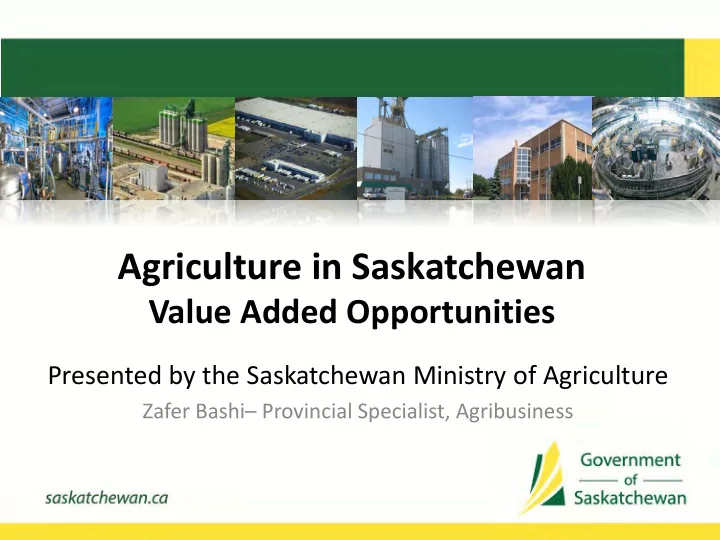

Agriculture in Saskatchewan Value Added Opportunities Presented by the Saskatchewan Ministry of Agriculture Zafer Bashi– Provincial Specialist, Agribusiness
Agriculture in Saskatchewan Saskatchewan … • Has 42% of Canada’s agricultural land = 18.2 M hectares • Is home to 37,000 farms; average farm size is 586 hectares • Is Canada’s top agri-food exporter • Agri-food exports reached a record $15.3 billion in 2015, accounting for nearly half of all provincial exports • Has 1/3 of Canada’s cow herd • Significant exports to 15 countries
Saskatchewan: Feeding the world Top Five Export Markets: 1.The United States - $4.0 billion 2.China - $2.4 billion 3.India - $1.5 billion 4.Japan - $882 million 5.Mexico - $626 million
We grow a diversity of crops … Pulses Cereals Canola, mustard Hemp Flax Canaryseed Quinoa Superfruits
Farmland distribution in Canada Hay and field crops 0% Lentils Alfalfa and alfalfa 3% mixtures 15% Dry field peas Total wheat (20) 3% 30% Soybeans 5% Oats Canola (rapeseed) 5% 25% Barley 9% Total corn (20) 5% Data source: Statistics Canada
6 Definition of value added agriculture? • Any activity that increases the value of Saskatchewan grown products above commodity price levels 1. Saskatchewan grown products include food, feed, livestock and bio-products 2. Requires modification (transformation) of raw commodity, not simply cleaning and bagging 3. Results in quantifiable economic impact (contribution to GDP, retail / export focused)
Opportunities in Value Added • Pea processing for starch and protein fractions • Cereal processing for flour or malt • Livestock processing, beef, hogs, lamb • Oilseed processing for canola vegetable oil, mustard • Other crops, potatoes, berries, carrots • Food manufacturing ingredients
Example - Pea Processing in Saskatchewan Advantages … • Close to source – Large quantity of high quality pea supply available – Minimizes delays due to regulations and logistics – Shortens time between procurement and processing – More profitable as closer to North American markets • Province has low taxes and a business-friendly environment • Research support: including scientists working in pulse ingredient fractionation, isolates and their diverse uses (from health, to pet food, to industrial applications) • Timing is right to invest in pea processing in Saskatchewan • Existing pea processing competition is minimal, especially for wet processing
Pea Processing Opportunity • Pea ingredients include: – Proteins (isolates and concentrates) ~24 g/100 g – Soluble and insoluble fibre ~17 g/100 g – Starches and sugars ~25 g / 100 g – Antioxidants, vitamins and minerals – (low in oils ~ 1.3 g / 100 g) • Many uses: – Beverage formulations, health drinks – Snacks – Protein supplements – Non-meat protein option – Pet food – Starches (flour) for noodles – Starches for industrial uses (mining, oil and gas drilling) – Fibres for functional foods – Non-gluten, non-soy
Value Added Support Services • Saskatchewan provides support services for new investors to build, acquire or invest in value added processing in the province. • The Value Added Team will assist you in ensuring you find a good site and work with you to obtain all the information and costing services you need, including Water, Rail, Roads, Power, Natural Gas, Environment etc. to build your plant • We can facilitate meetings with existing companies who may be interested in partnerships and joint operations. • We can facilitate timely one on one meetings with the Crown Corporations who deliver these services
Priority zones for development: Considerations for development include: • Main CP and CN rail lines • Access to main highway for truck transport, access to Global Transportation Hub • Proximity to a population base; labour • Proximity to water source (potable and/or non-potable; sewer) • Proximity to main SaskPower or TransGas source • Location of potential competitors • If there is already an established processor • If within a municipality that welcomes processors (and provides tax exemptions) • Proximity to commodity source being used
Saskatchewan. Endless Opportunity www.saskatchewan.ca
Canola Production Globally World top rapeseed producers (2013)
Canola Production in Canada & SK Canola Production in Saskatchewan and Canada 20 Million Metric Tons 18 16 14 12 Saskatchewan Canada 10 8 6 4 2 0 2004 2005 2006 2007 2008 2009 2010 2011 2012 2013 2014
Canola Production and Processing in Canada and SK Canola Crushed Locally vs. Exported Canada 2014 Saskatchewan 2014 Crushed Crushed Crushed Crushed out of in out of in SK SK Canada Canada 54% 46% 47% 53%
Canola Production in Crop Districts (thousand tons) Virtex 30,000-35,000 Ton/yr Cargill 1 MM Ton/yr Specialty non GMO, cold pressed oil 521 420 Bungee 500,000 Ton/yr ADM 840,000 MM Tonne/yr 429 60% from Saskatchewan 478 334 608 612 Milligan 60,000 Ton/yr 172 328 463 107 71 32 236 271 13 18 124 225 80 Richardson 840,000 ton/yr Louis Dreyfus 850,000 ton/yr
Recommend
More recommend